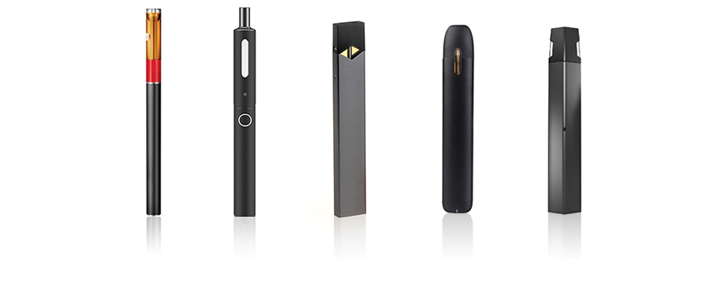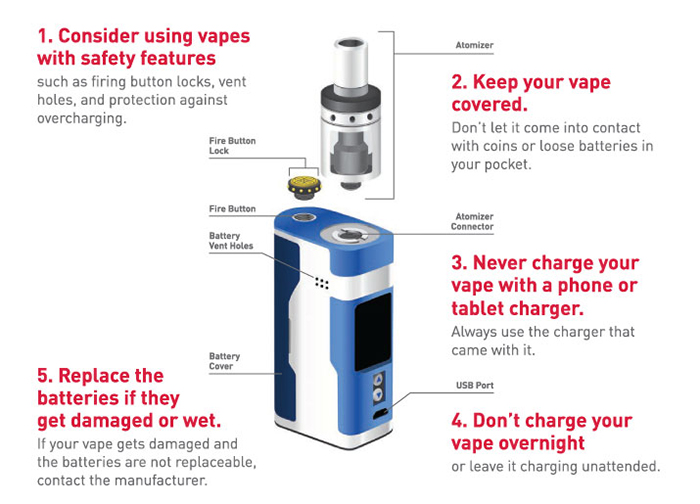Vaporizers, E-Cigarettes, and other Electronic Nicotine Delivery Systems (ENDS)
Vapes, vaporizers, vape pens, hookah pens, electronic cigarettes (e-cigarettes or e-cigs), and e-pipes are some of the many terms used to describe electronic nicotine delivery systems (ENDS). ENDS are noncombustible tobacco products.
These products use an “e-liquid” that may contain nicotine, as well as varying compositions of flavorings, propylene glycol, vegetable glycerin, and other ingredients. The liquid is heated to create an aerosol that the user inhales.
ENDS may be manufactured to look like conventional cigarettes, cigars, or pipes. Some resemble pens or USB flash drives. Larger devices, such as tank systems or mods, bear little or no resemblance to cigarettes.
Respiratory Illnesses Associated with Use of Vaping Products
Both the U.S. Food and Drug Administration and the U.S. Centers for Disease Control and Prevention are working tirelessly to investigate the distressing incidents of severe respiratory illness associated with use of vaping products.
Learn about FDA’s actions and recommendations for the public.
"The Real Cost" E-Cigarette Prevention Campaign
FDA's award-winning youth tobacco prevention campaign, "The Real Cost," expands to educate youth about the dangers of e-cigarettes.
Statistics about E-cigarette Use among U.S. Youth
- Among middle and high school students, 3.6 million were current users of e-cigarettes in 2020.1
- More than 8 out of 10 current youth users of e-cigarettes use flavored e-cigarettes, with fruit, mint, candy, and menthol flavors among the most commonly used.1
- According to a 2013-2014 survey, 81 percent of current youth e-cigarette users cited the availability of appealing flavors as the primary reason for use.2
FDA Regulation of Electronic Nicotine Delivery Systems
In 2016, FDA finalized a rule extending CTP's regulatory authority to cover all tobacco products, including electronic nicotine delivery systems (ENDS) that meet the definition of a tobacco product. FDA regulates the manufacture, import, packaging, labeling, advertising, promotion, sale, and distribution of ENDS, including components and parts of ENDS but excluding accessories. Examples of components and parts of ENDS include:
- E-liquids
- A glass or plastic vial container of e-liquid
- Cartridges
- Atomizers
- Certain batteries
- Cartomizers and clearomizers
- Digital display or lights to adjust settings
- Tank systems
- Drip tips
- Flavorings for ENDS
- Programmable software
Products marketed for therapeutic purposes (for example, marketed as a product to help people quit smoking) are regulated by FDA Center for Drug Evaluation and Research (CDER). FDA published a rule clarifying when products made or derived from tobacco are regulated as tobacco products, drugs, and/ or devices.
In January 2020, FDA issued an enforcement policy on unauthorized flavored cartridge-based e-cigarette products, including fruit and mint flavors, that appeal to kids. For more information, see the final guidance: Enforcement Priorities for Electronic Nicotine Delivery System (ENDS) and Other Deemed Products on the Market Without Premarket Authorization.
Manufacturing Electronic Nicotine Delivery Systems and E-Liquids
If you make, modify, mix, manufacture, fabricate, assemble, process, label, repack, relabel, or import ENDS, you must comply with the requirements for manufacturers.
CTP's Office of Small Business Assistance can answer specific questions about requirements of small businesses and how to comply with the law. This office also provides online educational resources to help regulated industry understand FDA regulations and policies.
Required Nicotine Addictiveness Warning on Packages and Advertisements
Beginning in 2018, all "covered" tobacco products* must bear the required nicotine addictiveness warning statement on product packages and advertisements. *Note: Cigars, which are also “covered” tobacco products, have additional required warning statements.
Retail Sales of Electronic Nicotine Delivery Systems and, E-Liquids
Center for Tobacco Products
Exchange Lab
Embed CTP content on your website for free. Through The Exchange Lab, when content is updated on our site, it will automatically update on your site as well.
Note: On December 20, 2019, the President signed legislation to amend the Federal Food, Drug, and Cosmetic Act, and raise the federal minimum age of sale of tobacco products from 18 to 21 years. It is now illegal for a retailer to sell any tobacco product – including cigarettes, cigars and e-cigarettes – to anyone under 21. FDA will provide additional details on this issue as they become available, and the information on this page will be updated accordingly in a timely manner.
If you sell ENDS, e-liquids, or their components or parts made or derived from tobacco, please read this summary of federal rules that retailers must follow.
You can find a list of retailer responsibilities for ENDS in the final rule Deeming Tobacco Products To Be Subject to the Federal Food, Drug, and Cosmetic Act. In addition, our website offers more information on regulations, guidance, and webinars for retailers.
Vape Shops That Mix E-Liquids or Modify Products
If you operate a vape shop that mixes or prepares liquid nicotine or nicotine-containing e-liquids, or creates or modifies any type of ENDS, you may be considered a manufacturer. As a result, some vape shops may have legal responsibilities as both manufacturers and retailers of tobacco products. Please also see the Guidance: Interpretation of and Compliance Policy for Certain Label Requirement; Applicability of Certain Federal Food, Drug, and Cosmetic Act Requirements to Vape Shops.
Importing Electronic Nicotine Delivery Systems and E-Liquids
Tobacco products imported or offered for import into the United States must comply with all the applicable requirements under the Federal Food, Drug, and Cosmetic Act (FD&C Act).
You can also learn more about the importation process in the FDA Regulatory Procedures Manual, Chapter 9, Import Operations and Actions.
If you have questions about importing a specific tobacco product, please contact the FDA district into which your product will be imported.
Report a Problem with a Tobacco Product or Potential Tobacco Product Violations
If you have experienced undesired health or quality problems with a specific tobacco product, you can report a problem with any tobacco product, including vapes, to the FDA. Knowledge about adverse experiences can help the FDA identify health or quality problems beyond those normally associated with tobacco product use.
If you believe these products are being sold to minors, or you see another potential violation of the FD&C Act or FDA’s tobacco regulations, report the potential violation.
You can read the adverse experience reports for tobacco on the Tobacco Product Problem Reports page.
Additional Resources
- FDA finalizes enforcement policy on unauthorized flavored cartridge-based e-cigarettes that appeal to children, including fruit and mint
- FDA takes steps to address epidemic of youth e-cigarette use, including a historic action against more than 1,300 retailers and 5 major manufacturers for their roles perpetuating youth access
- Small Business Assistance for Tobacco Product Industry
- Manufacturing
- Selling Tobacco Products in Retail Stores
- Tips to Help Avoid "Vape" Battery Explosions
- FDA's Deeming Regulations for E-Cigarettes, Cigars, and All Other Tobacco Products
- Guidance: Premarket Tobacco Product Applications for Electronic Nicotine Delivery Systems (ENDS)
- Guidance: Interpretation of and Compliance Policy for Certain Label Requirement; Applicability of Certain Federal Food, Drug, and Cosmetic Act Requirements to Vape Shops
- Federal Aviation Administration: Vapes On a Plane Marketing Kit
1. Wang TW, Neff LJ, Park-Lee E, Ren C, Cullen KA, King BA. E-cigarette Use Among Middle and High School Students — United States, 2020. MMWR Morb Mortal Wkly Rep. ePub: 9 September 2020.
2. Villanti AC, Johnson AL, Ambrose BK, et al. Use of flavored tobacco products among U.S. youth and adults; findings from the first wave of the PATH Study (2013-2014)





